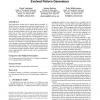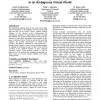75 search results - page 14 / 15 » Exploring network topology evolution through evolutionary co... |
GECCO
2005
Springer
14 years 14 days ago
2005
Springer
Self-organization of brain areas in animals begins prenatally, evidently driven by spontaneously generated internal patterns. The neural structures continue to develop postnatally...
BMCBI
2011
12 years 10 months ago
2011
Background: Flux coupling analysis (FCA) is a useful method for finding dependencies between fluxes of a metabolic network at steady-state. FCA classifies reactions into subsets (...
GECCO
2005
Springer
14 years 14 days ago
2005
Springer
The fundamental challenge faced by any visual system within natural environments is the ambiguity caused by the fact that light that falls on the system’s sensors conflates mult...
MOBICOM
2003
ACM
14 years 5 days ago
2003
ACM
One of the most important methods for evaluating the characteristics of ad hoc networking protocols is through the use of simulation. Simulation provides researchers with a number...
WS
2003
ACM
14 years 5 days ago
2003
ACM
Recent results indicate scalability problems for flat ad hoc networks. To address the issue of scalability, self-organizing hierarchical ad hoc architectures are being investigat...


